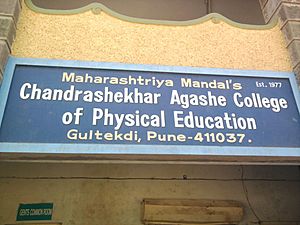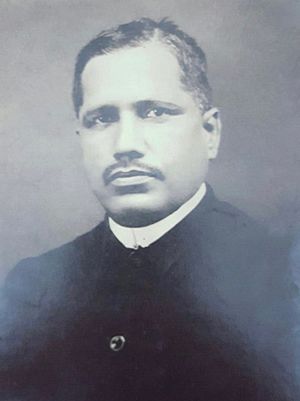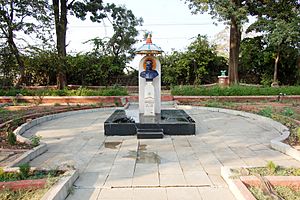Chandrashekhar Agashe facts for kids
Quick facts for kids
Chandrashekhar Agashe
|
|
|---|---|
|
चंद्रशेखर आगाशे
|
|

Agashe, oil on canvas by Raghuveer Bharam, at Brihan Maharashtra College of Commerce, 1997
|
|
| Managing Agent of the Brihan Maharashtra Sugar Syndicate Ltd. | |
| In office 21 September 1934 – 9 June 1956 |
|
| Succeeded by | K. V. Champhekar |
| President of the Bhor State Council | |
| In office 1932–1934 |
|
| Monarch | Raghunathrao II Shankarrao, 11th Raja of Bhor |
| Secretary of the Bhor State Council | |
| In office 1932–1932 |
|
| Monarch | Raghunathrao II Shankarrao, 11th Raja of Bhor |
| Chief Justiciar of the Bhor State | |
| In office 1920–1932 |
|
| Monarch | Shankarrao Chimnajirao, 10th Raja of Bhor (till 1922); Raghunathrao II Shankarrao, 11th Raja of Bhor (till 1932) |
| Personal details | |
| Born |
Chandrashekhar Govind Agashe
14 February 1888 Bhor, Bhor State, Poona Agency, British Raj |
| Died | 9 June 1956 (aged 68) Pune, Maharashtra, India |
| Cause of death | Myocardial infarction |
| Spouse |
Indirabai Agashe (née Dwarka Gokhale)
(m. 1914) |
| Children | 11 (including Jagdish "Panditrao" Agashe, Dnyaneshwar Agashe and Shakuntala Karandikar) |
| Parents | Govind Agashe II (father) and Radhabai Agashe (mother) |
| Alma mater | Fergusson College (B.A.), Government Law College, Mumbai (L.L.B.) |
| Occupation | Industrialist, lawyer, educator |
| Signature | |
Chandrashekhar Govind Agashe (Marathi: चंद्रशेखर आगाशे; 14 February 1888 — 9 June 1956) was an important Indian businessman and lawyer. He is best known for starting the Brihan Maharashtra Sugar Syndicate Ltd., a big sugar company. He was the main leader of this company from when it started in 1934 until he passed away in 1956. He also served as the President of the Bhor State Council from 1932 to 1934.
Today, several places are named after him. These include the Chandrashekhar Agashe College of Physical Education in Pune and a special research center at the Brihan Maharashtra College of Commerce. There's also the Chandrashekhar Agashe High School in Shreepur, Maharashtra. A part of the Raja Dinkar Kelkar Museum is also named after him, as is a road in Shaniwar Peth, Pune. He even inspired a business idea called the Agashe pattern, which was a way for businesses to raise money from many people.
Contents
About Chandrashekhar Agashe
His Early Life and Family: 1888–1914
Chandrashekhar Agashe was born on 14 February 1888 in a town called Bhor. At that time, Bhor was part of the Bhor State in what is now Maharashtra, India. He was the oldest of four children. His parents were Govind Agashe II and Radhabai Agashe.
His family, the Agashes, were a respected family of Brahmins. They had been important in the Bhor State since the 1590s. They traditionally worked as money lenders and judges for the Pantsachiv Kings. They owned a lot of land and continued their family businesses. Agashe's father was the only Brahmin money lender at the royal court when Chandrashekhar was born.

When Agashe was 11, his father died. His relatives unfairly took over the family lands, forcing his mother and siblings to leave their home. In 1900, they moved to his grandparents' house in Shaniwar Peth, Pune. To help his family and pay for school, Agashe worked secretly at the Indian Post Office. Later, he inherited a temple in Shaniwar Peth. He finished high school in 1905 and earned a Bachelor of Arts degree from Fergusson College in 1914.
In 1914, Agashe married Dwarka Gokhale. Her family was also well-known and had been royal jewelers. After marriage, she changed her name to Indirabai Agashe. They had eleven children together, though nine lived to adulthood. Their sons included Jagdish "Panditrao" Agashe and Dnyaneshwar Agashe.
Working as a Teacher and Lawyer: 1914–1934
From 1914 to 1917, Agashe taught mathematics at the Nutan Marathi Vidyalaya in Pune. After that, he was a visiting professor in Karachi. From 1917 to 1926, he worked as a teacher in Mumbai while studying law. He earned his law degree from the Government Law College, Mumbai in 1919. He then started working as a lawyer in Pune and advised the Bhor State government on laws.
Between 1920 and 1932, he was appointed the Chief Judge at the royal court of Bhor. He served under two kings, Shankarrao Chimnajirao and Raghunathrao II Shankarrao. During this time, there was a lot of unrest between common people and the rich in Bhor State, leading to riots. Agashe wrote an article with Narasimha Chintaman Kelkar in the Kesari newspaper about this problem. With the king's permission, he set up a "Lokpaksh" to ensure fair trials and resolve conflicts.
However, the "Lokpaksh" didn't get much support, and Agashe thought about leaving law in the late 1920s. After hearing a speech by Bal Gangadhar Tilak, Agashe and his family started following the ideas of the Swadeshi movement. This movement encouraged people to use Indian-made goods. He began to think about starting his own business to help India's independence movement in Maharashtra. Agashe supported many Indian freedom fighters, but he never wanted to be a politician himself. His younger brother, Narayan Agashe III, was active in politics and even went to prison for protesting against the British. He later helped Chandrashekhar with his business.
In 1932, Agashe became the Secretary of the Bhor State Council. In less than a year, he was chosen as the President of the Council, a position he held until 1934. As president, he helped small and new businesses in Maharashtra with money and legal advice. During his time as president, he also used his legal skills to get his family's lost lands back from his relatives.
Starting the Brihan Maharashtra Sugar Syndicate Ltd.: 1934–1956
In 1933, the Governor of Bombay encouraged the production of local sugar. This was because the tax on sugar imported from Mauritius had increased. This gave Agashe the idea to start the Brihan Maharashtra Sugar Syndicate Ltd. He officially started the company on 21 September 1934. He raised money from many middle-class people in Maharashtra to fund it. Before starting the syndicate, Agashe helped Atmaram Raoji Bhat create the Mahratta Chamber of Commerce in March 1934. He also guided the Chamber to pass laws with the Government of Mumbai to ensure government help for all factory businesses in Maharashtra.
Between 1934 and 1936, Agashe wanted to open a factory branch of the Syndicate in his hometown of Bhor. He started preparing 2,000 acres of land to grow sugar cane. However, he faced strong opposition from local landowners, so the factory plans in Bhor were stopped. In 1935, he began hiring local farmers to grow or transport sugar cane for the syndicate in the village of Bhorgaon. By 1936, he had bought or leased 12,000 acres of farmland to support the company. People praised him for helping the local economy, and he received more land from bankers and politicians. During this time, because Agashe was a Brahmin, some local Maratha politicians opposed the syndicate.
Agashe set up the syndicate's main office in the Commonwealth Building on Laxmi Road. In January 1935, the Mahratta Chamber of Commerce announced the sale of 300,000 shares of the syndicate, with each share costing Rs. 25. From 1935 to 1937, Agashe traveled to many villages, promoting the syndicate and encouraging people to invest. The Kesari newspaper supported him with public relations, and the new Bank of Maharashtra gave him financial help. Agashe's way of raising money was known as the Agashe pattern in Pune. This method involved collecting money from many people as ownership shares (equity) instead of loans. Agashe became famous for this because he was one of the first in Maharashtra to successfully raise funds this way. In November 1937, Agashe ordered sugar cane processing machines from Škoda Works in Czechoslovakia before World War II began. Even after Adolf Hitler took power and Germany occupied Czechoslovakia, Agashe received the machines.

He started building the first factory in April 1938. The syndicate's first sugar cane processing factory opened in Bhorgaon in March 1939. He also bought an estate and surrounding lands to manage his own sugar plantations. By 1940, the factory was producing 150,000 bags of sugar each year. The sugar was sold under the brand name Shree, and the village of Bhorgaon even changed its official name to Shreepur. At this time, Agashe continued to practice law in Pune.
In 1943, during World War II, the Bombay Presidency made it compulsory for private sugar makers to grow food crops to support British troops. Agashe started the Laxmi Narayan Farmers' Union to meet this demand without stopping sugar cane processing. This was not popular with some farmers because it wasn't very profitable for them. After Indian independence in 1947, Agashe was able to expand the syndicate's production to process 1000 tonnes of sugar cane per year by 1950.
By 1953, some people criticized Agashe's leadership of the syndicate. This was due to some issues and court cases where he or the company were accused of misleading shareholders. Agashe responded to these accusations by writing all the company's press releases himself in the Kesari newspaper. These articles were known for their humor and references to popular culture. He also published a 400-page report, saying that his critics were corrupt and supported by a competitor who wanted to buy the syndicate.
His Passing: 1956
On 9 June 1956, Chandrashekhar Agashe was on a spiritual trip in Jogeshwari. He started feeling symptoms of a myocardial infarction (heart attack). His doctor advised him to go home. He died that same day from a heart attack when he reached his home in Shaniwar Peth, Pune. He had built a strong company with a good management system. After his death, S. L. Limaye became the chairman, and K. V. Champhekar became the managing director. Later, Agashe's sons, Panditrao and Dnyaneshwar, became joint managing directors in 1970.
Helping Others (Philanthropy)
Agashe was very generous. His most important donation was for the creation of the Brihan Maharashtra College of Commerce in November 1944. He gave money for the college's buildings to the Deccan Education Society. Because of his donation, the college was named after his sugar syndicate. His money also helped other schools and institutions. Some people criticized his charity, saying it was for his own benefit.
Agashe started building the Agashe Primary School in the village of Shreepur in April 1942. The government approved the school in July 1943. He also donated money to support the Indian freedom fighter Narhar Vishnu Gadgil. He gave money to the Bhandarkar Oriental Research Institute for their research on the Mahabharata. He also created the Brihan Maharashtra Bhavan in New Delhi for the growing Marathi community there.
His Lasting Impact

Chandrashekhar Agashe passed away from a heart attack at age 68 on 9 June 1956, at his home in Shaniwar Peth, Pune. His wife, Indirabai Agashe, lived until 1981. His sons, Panditrao Agashe and Dnyaneshwar Agashe, continued his business legacy. He is remembered as one of the most important people from Pune in the 20th century.
In July 1977, the founder of the Mahrashtriya Mandal of Pune, Shivrampant Damle, established the Chandrashekhar Agashe College of Physical Education in Pune, honoring Agashe after his death. The Pune Municipal Corporation also renamed the street in Shaniwar Peth, Pune where his family lived as Chandrashekhar Agashe Road.
In 1993/94, the Brihan Maharashtra College of Commerce celebrated its 50th anniversary. They created the Chandrashekhar Govind Agashe Business Motivation, Training and Research Centre (CGA – BMTRC) in his honor, which opened in August 1998.
Agashe's sons started building the Chandrashekhar Agashe High School in the village of Shreepur in 1955. They also donated his family's collection of old Indian musical instruments to the Raja Dinkar Kelkar Museum. This exhibit was named the Chandrashekhar Agashe Museum wing.
In 1992, Agashe's second-eldest daughter, Shakuntala Karandikar, wrote a book about his life. In 1997, his great-grandson was named Chandrashekhar Agashe II after him. In 2004, the Pune Heritage department of the Kesari Trust honored Agashe with a special plaque outside his former home in Shaniwar Peth, Pune.
See also
 In Spanish: Chandrashekhar Agashe para niños
In Spanish: Chandrashekhar Agashe para niños




